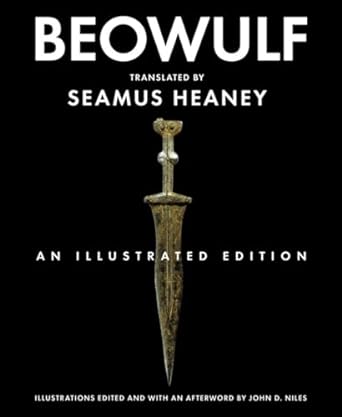This post is more impression and thoughts about translation than it is book review. Beowulf – we likely read it at some point during our education – Anglo Saxon / Old English and all that. Seamus Heaney gives us a “modern” translation and it is beautiful to read, vivid, alive. I’m afraid that I won’t do either Beowulf or Seamus Heaney justice, although I loved the book and read cover-to-cover (3182 poetic lines / 260 pages of text and illustration) in only three sittings (and then read it again, and then skimmed it this morning). What I really love even more than the poem is Heaney’s introduction.
Although written by an early English Christian between the middle 7th and the 10th century (about 1,500 years ago) the action took place (if it actually took place) before the arrival of the Anglo Saxons and it wasn’t even an “English” story. The oral story took place during the pagan period before the King Author legends that we’re familiar with through various books and films.
Beowulf, the poem, describes the life of a Nordic prince, a warrior, an honourable man who fights monsters and a dragon. It is the re-telling of an heroic narrative that seems to have taken place in what we know as Scandinavia. It’s important book, Beowulf being the first written in English and is, therefore, historically significant. The original is kept in the British Library. But besides being the first, Heaney calls Beowulf, “a work of great imaginative vitality.” (An aside: J.R.R. Tolkien also translated Beowulf, and the poem’s influence can be seen in Tolkien’s writing.)
Heaney tells us the context of Beowulf is within “a pagan Germanic society governed by a heroic code of …conduct….” He says, “the poem possesses a mythic potency” (ix). I wished, as I was reading the book, to see a copy without the Christian overlay, see it as the bards of old might have told the tale.
One thing that clung to me as I read the epic, was Heaney’s introduction that reflects on the experience of translating (which took Heaney 35 years from the initial contract – he put it aside for long periods). Heaney writes: “I noticed that without any conscious intent on my part certain lines in the first poem in my first book conformed to the requirements of Anglo-Saxon metrics. These poems were made up of two balancing halves, each half containing two stressed syllables – the spade sinks into gravelly ground: / My father, digging. I look down’ – and ‘down’ across the caesura. Part of me, in other words, had been writing Anglo-Saxon from the start (xviii).
In the process of translating, Heaney writes:
In one area, my own labours have been less than thorough-going. I have not followed the strict metrical rules that bound the Anglo-Saxon scop. I have been guided by the fundamental pattern of four stresses to the line, but I allow myself several transgressions. For example, I don’t always employ alliteration, and sometimes I alliterate only one half of the line. When these breaches occur, it is because I prefer to let the natural “sound of sense” prevail over the demands of the convention: I have been reluctant to force an artificial shape or an unusual word choice just for the sake of correctness (xxii-xxiii).
What poet wouldn’t love Seamus Heaney?
Before we meet Beowulf, we meet Grendel, the monster who is attacking the Danes: Then a powerful demon, a prowler through the dark, / nursed a hard grievance. I harrowed him / … (lines 86-87), and we begin by seeing the story through the monster’s eyes before we learn what Beowulf and the Danes’ experienced. The story, as you might imagine, takes twists and turns until Beowulf meets the dragon and the climax is reached. You might call Beowulf fantasy; you might call it metaphor.
Seamus Heaney’s Beowulf is a very good read, even in the 21st century.

Available through your local bookstore or online: ISBN: X003XQKRA7
